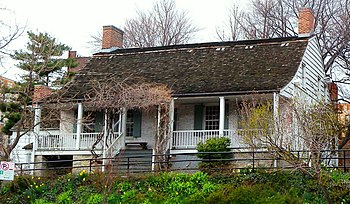Dyckman House
|
Dyckman House
|
|

(2011)
|
|
| Location | 4881 Broadway, Inwood, Manhattan, New York City |
|---|---|
| Nearest city | New York City |
| Coordinates | 40°52′2.5″N 73°55′23″W / 40.867361°N 73.92306°WCoordinates: 40°52′2.5″N 73°55′23″W / 40.867361°N 73.92306°W |
| Built | c.1785 |
| Architectural style | Dutch Colonial |
| NRHP Reference # | 67000014 |
| Significant dates | |
| Added to NRHP | December 24, 1967 |
| Designated NHL | December 24, 1967 |
| Designated NYCL | July 12, 1967 |
The Dyckman House, now the Dyckman Farmhouse Museum, is the oldest remaining farmhouse on Manhattan island, a reminder of New York City's rural past. The Dutch Colonial-style farmhouse was built by William Dyckman, c.1785, and was originally part of over 250 acres (100 ha) of farmland owned by the family. It is now located in a small park at the corner of Broadway and 204th Street in the Inwood neighborhood of the city.
Dyckman was the grandson of Jan Dyckman, who came to the area from Westphalia in 1661. William Dyckman, who inherited the family estate, built the current house to replace the family house located on the Harlem River near the present West 210th Street, which he had built in 1748, and which was destroyed in the American Revolutionary War.
The current two-story house is constructed of fieldstone, brick and white clapboard, and features a gambrel roof and spring eaves. The porches are typical of the Dutch Colonial style, but were added in 1825. The house's interior has parlors and an indoor (winter) kitchen, with floors of varying-width chestnut wood. The house's outdoor smokehouse-summer kitchen, in a small building to the south, may predate the house itself.
The house stayed in the family for several generations until it was sold in 1868, after which it served as a rental property for several decades. By the beginning of the 20th century, the house was in disrepair and in danger of being demolished, and the Dyckman family bought it back in 1915. Two sisters of the family, Mary Alice Dyckman Dean and Fannie Fredericka Dyckman Welch, began a restoration of the farmhouse in 1915-16 under the supervision of architect Alexander M. Welch, the husband of Fannie. They then transferred ownership of the house to the City of New York in 1916, which opened it as a museum of Dutch and Colonial life, featuring the original Dyckman family furnishings.
...
Wikipedia



